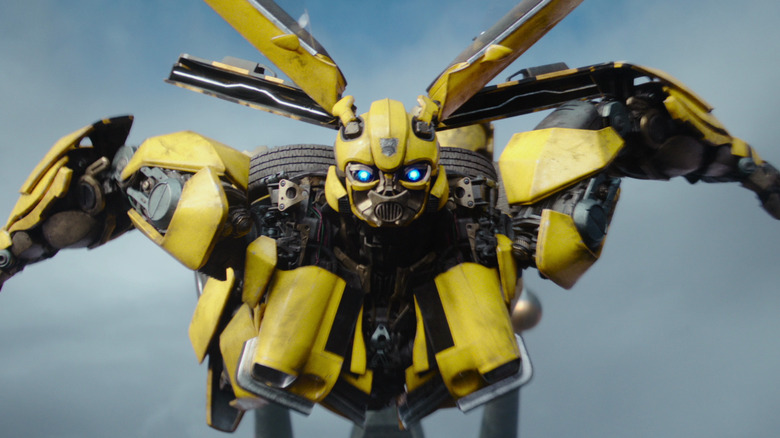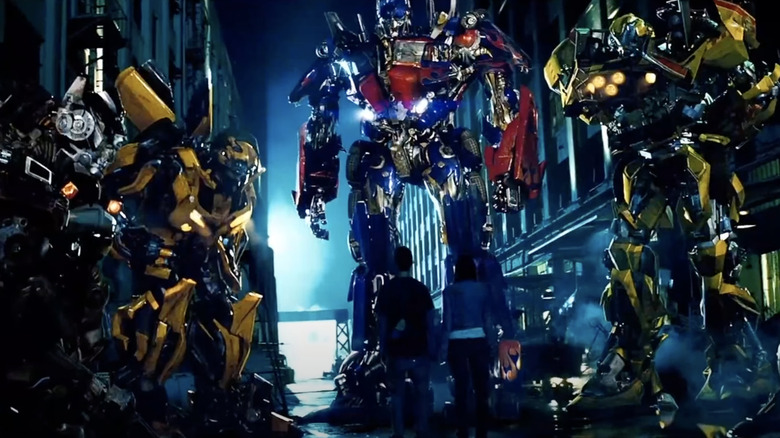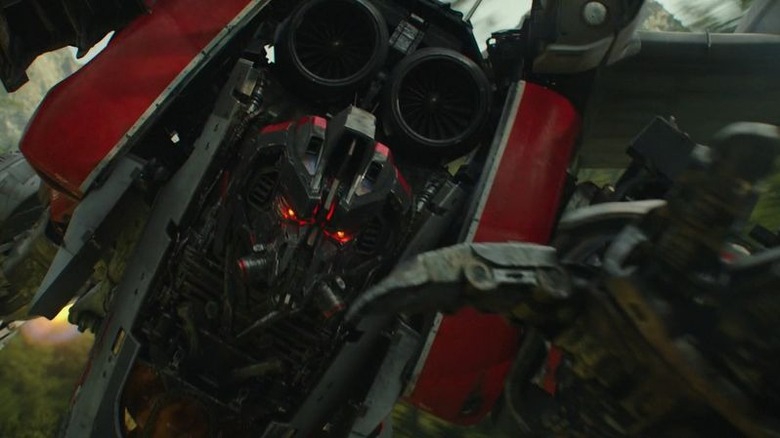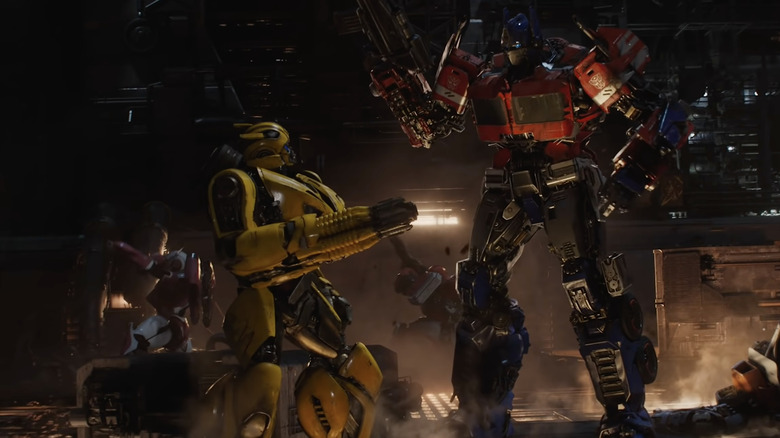Are Transformers: Rise Of The Beasts And Bumblebee Prequels Or Reboots? An Investigation
Has the "Transformers" film series been rebooted or not? Even after watching the latest film, "Transformers: Rise of the Beasts," I'm still not sure. The films sat in the grip of director Michael Bay for a decade and five straight installments — far too long. Now, Bay has stepped back into a producer role; 2018's "Bumblebee," a spin-off about the eponymous Autobot, was the first live-action "Transformers" film not directed by Bay, but instead by Laika co-founder/Nike heir Travis Knight.
"Bumblebee" definitely began life as a prequel — it's set in the 1980s, preceding the 2007 "Transformers" film — but the final cut felt like a fresh start, one that could lead to a new story rather than the Bay films. That it got far better reviews and fan reactions than Bay's films also contributed to this feeling.
At the 2019 New York Toy Fair, "Transformers" owner Hasbro declared "Bumblebee" to be the beginning of "a new storytelling universe." Many hopeful fans took this confirmation of a reboot, but I find it to be a mealy-mouthed attempt at playing both sides. "Rise of the Beasts" continues on from "Bumblebee," but is just as unsure about whether or not it's following in the Bay movies' footsteps. So let's see if we can piece together an answer to this mystery.
They're reboots
Two scenes in "Bumblebee" are the crux of this dispute: an opening showing the Autobots evacuating Cybertron as the Decepticons overwhelm them, and then a flashback carrying on from that opening. In these scenes, the Transformers all have designs that owe much more to the "Generation One" originals than the Bay movies; they're cleaner, blockier, and more colorful with humanoid faces. The characters in these scenes, from Optimus Prime to Soundwave, look like HD versions of their classic selves. This sort of aesthetic rebrand is more fitting for a reboot than a prequel.
There's also the continuity — or lack thereof. In "Bumblebee," the Autobot first arrives on Earth in the 1980s. However, according to the Bay films, he'd been here decades prior to that and even fought in World War 2. The film ends with other Autobots coming to Earth, where they remain as of "Rise of the Beasts," even though in the Bay movies they first came in 2007. "The Last Knight" revealed that Earth is actually a dormant Unicron, but in "Rise of the Beasts," the Chaos-Bringer is an entirely separate being; the climax of the film is about stopping him from destroying Earth.
With all these inconsistencies, it sounds like less of a headache to just declare the post-Bay "Transformers" movies as reboots, set in their own continuity. However, it's not that simple.
They're prequels
Unlike the other Autobots, Bumblebee continues to look a lot like he did in the Bay-directed movies, down to the same head design, Camaro vehicle mode, and speech impediment. "Bumblebee" (the movie) also featured Sector Seven, the Transformer-hunting government agency from the 2007 "Transformers" film.
That organization was a creation of the Bay films; "Bumblebee" likewise depicted them as being based out of the Hoover Dam, while Nick Pilla makes a cameo as a young Agent Seymour Simmons (played by John Turturro in the Bay movies). A deleted post-credits scene from "Bumblebee" — showing Sector Seven in possession of "N.B.E 01," aka a frozen Megatron — would've tied the movie even further to the 2007 film.
Now, one could argue this scene's removal is further evidence for the "reboot" column. However, Megatron is notably absent from the Cybertron-set opening, where the Decepticons are instead led by his generals. Travis Knight told io9, "I had this whole thing boarded where we see Megatron and he comes in like Sauron, just blowing s*** up and laying waste to everything." However, he decided to cut this because it would have contradicted the 2007 film. At TFCon in 2019, voice actor Jon Bailey (who voiced Soundwave and Shockwave in "Bumblebee") was asked about Megatron's absence. He bluntly replied, "Well ["Bumblebee"] is a prequel, so Megatron is still frozen on Earth."
As for the other continuity hiccups? Continuity has never been a priority in this franchise. Each film adds a new, unbelievable wrinkle to the Decepticons' master plan and some new connection between the history of humanity and the Transformers. "The Last Knight" tried (and failed) to make a greater mythology out of this. As such, any errors can't really be counted as proof of a reboot.
The answer
To understand this messy storytelling, you have to understand what happened behind the scenes. "Bumblebee" was originally going to hew much closer to the Bay movies. The film originally had a different opening sequence: one set on Earth that ran with the idea Bumblebee had been on the planet for decades. The prequel comic, written by John Barber and drawn by Andrew Griffith, was also written with this idea in mind, throwing Bumblebee into a 60s-set spy thriller.
But then, "Transformers: The Last Knight" lost $100 million for Paramount, indicating a public that was finally tired of the diminishing returns in the quality of Bay's "Transformers." That created incentive for Paramount to distance "Bumblebee" from "The Last Knight." Part of this also boils down to the different preferences between Bay and Knight.
Knight was 11 years old in 1984 when "Transformers" debuted and, naturally, he's a fan of the franchise (unlike Bay, who had obvious contempt for the material). Even when cut together as a prequel, "Bumblebee" had some nods to "Generation One" — for instance, the brief holographic appearance of Optimus Prime in his "G1" design, or the Decepticon Blitzwing, whom Bumblebee fights and slays in the opening. The latter has a design modeled on the Seekers: the Decepticon trio of Starscream, Thundercracker, and Skywarp, who all shared a body type (but different color schemes) and fighter jet vehicle modes. When the "Bumblebee" teaser dropped, most viewers originally assumed that Blitzwing was Starscream.
Schrödinger's Prime
The Cybertron-set opening of "Bumblebee" was a last-minute addition, devised by Knight and screenwriter Christina Hodson after test audiences wanted more Transformers. The scene was whipped up with only a few months left before release by the film's crew and Industrial Light & Magic. Due to the crunch time, the team retrofitted pre-existing CGI models (Bumblebee, Optimus Prime, Blitzwing, and the Decepticon Shatter) to create the new Autobots and Decepticons in the opening. Knight's affinity for "Generation One" meant that's what these new designs were based on. ILM shares the details about their work here.
Despite the success of "Bumblebee," there's another player here: producer Lorenzo di Bonaventura, who's been with the franchise since the beginning and is still present even with Bay gone. In 2019, he went on record that future "Transformers" movies would have "more Bayhem," and indeed, "Rise of the Beasts" does try to balance Bay's insanity with Knight's sentimentality. Bonaventura has a vested, sunk-cost interest in the Bay "Transformers" movies — he oversaw them, after all — so while he's in charge, we'll probably never get an "official" confirmation that the new movies are reboots. Admitting they are would mean admitting a failure, and doing so would be a self-inflicted blot on Bonaventura's record.
For now, it's best to take each "Transformers" movie on its own terms. That certainly seems to be the attitude of the people making them.
"Transformers: Rise of the Beasts" is playing in theaters.




